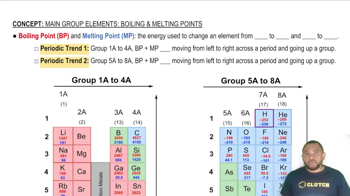The following pictures represent structures of the hydrides of four second-row elements:
(1)
(2)
(3)
(4)
(a) Which compound has the highest melting point?
 Verified step by step guidance
Verified step by step guidance



The following pictures represent structures of the hydrides of four second-row elements:
(1)
(2)
(3)
(4)
(a) Which compound has the highest melting point?
The following pictures represent structures of the hydrides of four second-row elements:
(1)
(2)
(3)
(4)
(b) Which compound has the lowest boiling point?
Look at the location of elements A, B, C, and D in the following periodic table:
(b) Classify each oxide as basic, acidic, or amphoteric.
Consider the six second- and third-row elements in groups 4A–6A of the periodic table:
Possible structures for the binary fluorides of each of these elements in its highest oxidation state are shown below.
(a) Identify the nonfluorine atom in each case, and write the molecular formula of each fluoride.
Consider the six second- and third-row elements in groups 4A–6A of the periodic table:
Possible structures for the binary fluorides of each of these elements in its highest oxidation state are shown below.
(b) Explain why the fluorides of nitrogen and phosphorus have different molecular structures but the fluorides of carbon and silicon have the same molecular structure.
Which of the following elements (X) will form a covalent hydride with the formula XH3 that is a gas at room temperature? (LO 22.4)
(a) Al (b) As (c) Ba (d) Se